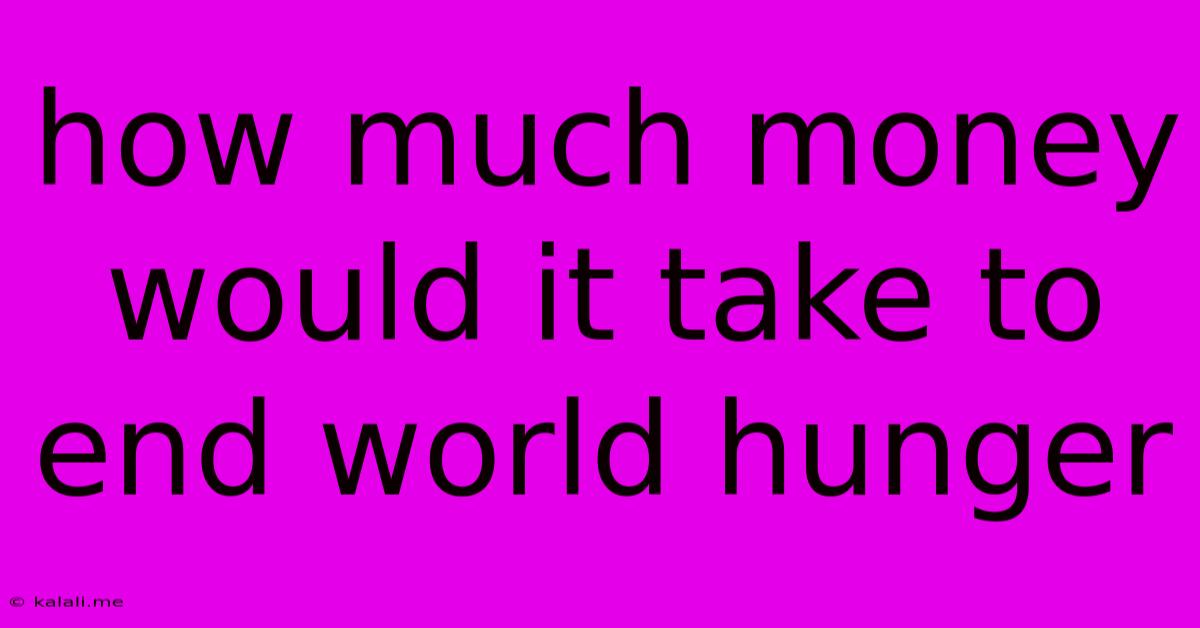How Much Money Would It Take To End World Hunger
Kalali
Jun 01, 2025 · 3 min read

Table of Contents
How Much Money Would It Take to End World Hunger? A Complex Question with No Simple Answer
The question of how much money it would take to end world hunger is deceptively simple. While a single figure might seem appealing, the reality is far more nuanced. Ending world hunger isn't just about throwing money at the problem; it's a multifaceted challenge demanding a holistic approach that addresses systemic issues like poverty, conflict, climate change, and unequal food distribution. This article delves into the complexities of this issue, exploring the various factors that contribute to hunger and offering a more comprehensive understanding than a single dollar amount can provide.
The Challenges Beyond Funding: A Holistic View
While precise figures are difficult to obtain, estimates from organizations like the United Nations World Food Programme (WFP) suggest that eradicating hunger requires significantly more investment than currently provided. However, simply increasing funding won’t automatically solve the problem. Consider these critical factors:
- Inefficient Food Systems: A substantial portion of food produced globally is lost or wasted due to inefficient storage, transportation, and processing. Addressing these inefficiencies through improved infrastructure and technology is crucial.
- Political Instability and Conflict: War and conflict are major drivers of hunger, disrupting food production and distribution networks, creating displacement, and hindering access to resources. Peacebuilding and conflict resolution are essential prerequisites.
- Climate Change: Extreme weather events, droughts, and floods significantly impact agricultural yields, exacerbating food insecurity, particularly in vulnerable regions. Climate-resilient agricultural practices and adaptation strategies are vital.
- Poverty and Inequality: Poverty remains the most significant contributor to hunger. Addressing systemic inequalities through sustainable development initiatives, fair trade practices, and poverty reduction programs is key.
- Access to Resources: Even when food is available, many people lack access due to geographical barriers, lack of infrastructure, or discriminatory practices. Improved infrastructure, transportation networks, and equitable distribution systems are crucial.
Beyond the Monetary: Investing in Sustainable Solutions
Instead of focusing solely on a monetary figure, it’s more effective to consider the investment needed in various sectors to create a sustainable solution. This includes:
- Agricultural Innovation: Investing in research and development for climate-resilient crops, improved farming techniques, and sustainable agricultural practices.
- Infrastructure Development: Improving transportation, storage, and processing infrastructure to minimize food loss and waste and enhance access to markets.
- Social Safety Nets: Strengthening social protection programs, including food assistance initiatives, to provide a safety net for vulnerable populations.
- Education and Empowerment: Empowering communities through education, training, and access to resources, particularly women, who play a vital role in food production and household food security.
- Conflict Resolution and Peacebuilding: Investing in peacebuilding efforts and addressing the root causes of conflict to create stable environments conducive to food security.
Conclusion: A Multifaceted Approach is Crucial
While a specific dollar amount to end world hunger is impossible to pinpoint accurately, it’s clear that a significantly larger investment is needed compared to current levels. However, this investment must be strategic and holistic, going beyond simply providing food aid. We need to address the root causes of hunger through sustainable solutions that tackle poverty, inequality, conflict, and climate change. The focus should be on building resilient food systems, empowering communities, and creating a just and equitable world where everyone has access to nutritious food. Only then can we truly hope to eradicate hunger permanently.
Latest Posts
Latest Posts
-
Using Rref To Solve System Of Differential Equations
Jun 02, 2025
-
What Does A Compressor Pedal Do
Jun 02, 2025
-
No Viable Alternative At Character
Jun 02, 2025
-
How To Fix A Scratched Tire Rim
Jun 02, 2025
-
I Definitely Have An Opinion On This
Jun 02, 2025
Related Post
Thank you for visiting our website which covers about How Much Money Would It Take To End World Hunger . We hope the information provided has been useful to you. Feel free to contact us if you have any questions or need further assistance. See you next time and don't miss to bookmark.